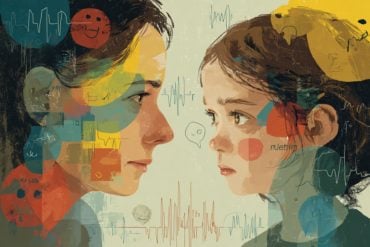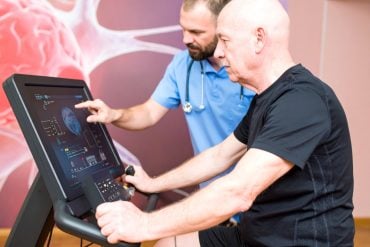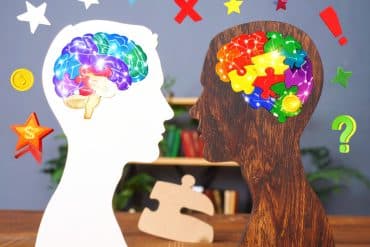Summary: Findings shed light on what happens in the brains of patients with functional neurological disorders as well as other trauma-related brain disorders.
Source: Mass General
In individuals with functional neurological disorder (FND), the brain generally appears structurally normal on clinical MRI scans but functions incorrectly (akin to a computer software crashing), resulting in patients experiencing symptoms including limb weakness, tremor, gait abnormalities and non-epileptic seizures. In some cases, childhood maltreatment may have been a contributing factor, yet links between risk factors such as childhood abuse and brain mechanisms for the development of FND remain poorly understood. In a new study published in Molecular Psychiatry, researchers led by investigators at Massachusetts General Hospital (MGH) examined the brains of individuals who experienced early-life trauma, some with FND and others without the condition. The findings may provide a better understanding of what happens in the brains of some patients with FND, as well as those with various other trauma-related brain disorders.
In the study of 30 adults with FND and 21 individuals whose clinical depression diagnoses served as controls, some of the participants in both groups had experienced early-life maltreatment, as determined through questionnaires. In FND patients only, differences in the severity of childhood physical abuse correlated with differences in connections between certain regions of the brain–for example, between the limbic regions which control emotions, arousal and survival instincts among other functions, and the primary motor cortex which is involved in voluntary movements.
“Motor and limbic circuits were more strongly interconnected in individuals with FND reporting a greater severity of childhood physical abuse,” explained lead author Ibai Diez, PhD, a senior research fellow in Neurology and Radiology at MGH. This finding may lead to potentially important insights on the plastic brain mechanisms involved in promoting increased cross-talk between motor control circuits and emotion processing circuits.

In additional assessments, investigators examined how the expression of genes in a publicly available data set from the Allen Institute related to brain areas showing prominent plastic effects correlated to the degree of early-life physical abuse in patients with FND. As background, some genes in the literature have been shown to increase risk for developing brain disorders after experiencing early-life maltreatment. The researchers found that brain areas showing prominent functional re-organization in patients with FND were the same brain areas highly expressing genes involved in neuroplasticity and nervous system development.
“Our study has potential implications regarding our understanding of brain-trauma relationships not only in patients with FND but also across the greater spectrum of trauma-related brain disorders,” said senior author David Perez, MD, MMSc, director of the MGH FND Clinical and Research Programs.
Perez stressed that although childhood maltreatment may be a risk factor for the development of FND in some individuals, there are many social, environmental, and biological factors that likely influence the development of FND later in life.
“More work is needed to understand how the brain mechanisms underlying FND in those without prominent childhood maltreatment may be the same or different as those individuals with FND with a high burden of childhood adversity,” he said.
Funding: The research was the result of a collaboration between the MGH Functional Neurology Research Group led by Perez, the laboratory of Jorge Sepulcre, MD, PhD, in MGH’s Gordon Center for Medical Imaging, Gregory Fricchione MD of the Benson-Henry Institute, the laboratory of Erin Dunn PhD, and Timothy Nicholson MD, PhD, of King’s College London.
Source:
Mass General
Media Contacts:
Terri Janos – Mass General
Image Source:
The image is in the public domain.
Original Research: Closed access
“Early-life trauma endophenotypes and brain circuit–gene expression relationships in functional neurological (conversion) disorder”. Ibai Diez, Anna G. Larson, Vihang Nakhate, Erin C. Dunn, Gregory L. Fricchione, Timothy R. Nicholson, Jorge Sepulcre & David L. Perez.
Molecular Psychiatry doi:10.1038/s41380-020-0665-0.
Abstract
Early-life trauma endophenotypes and brain circuit–gene expression relationships in functional neurological (conversion) disorder
Functional neurological (conversion) disorder (FND) is a neuropsychiatric condition whereby individuals present with sensorimotor symptoms incompatible with other neurological disorders. Early-life maltreatment (ELM) is a risk factor for developing FND, yet few studies have investigated brain network–trauma relationships in this population. In this neuroimaging–gene expression study, we used two graph theory approaches to elucidate ELM subtype effects on resting-state functional connectivity architecture in 30 patients with motor FND. Twenty-one individuals with comparable depression, anxiety, and ELM scores were used as psychiatric controls. Thereafter, we compared trauma endophenotypes in FND with regional differences in transcriptional gene expression as measured by the Allen Human Brain Atlas (AHBA). In FND patients only, we found that early-life physical abuse severity, and to a lesser extent physical neglect, correlated with corticolimbic weighted-degree functional connectivity. Connectivity profiles influenced by physical abuse occurred in limbic (amygdalar–hippocampal), paralimbic (cingulo-insular and ventromedial prefrontal), and cognitive control (ventrolateral prefrontal) areas, as well as in sensorimotor and visual cortices. These findings held adjusting for individual differences in depression/anxiety, PTSD, and motor phenotypes. In FND, physical abuse also correlated with amygdala and insula coupling to motor cortices. In exploratory analyses, physical abuse correlated connectivity maps overlapped with the AHBA spatial expression of three gene clusters: (i) neuronal morphogenesis and synaptic transmission genes in limbic/paralimbic areas; (ii) locomotory behavior and neuronal generation genes in left-lateralized structures; and (iii) nervous system development and cell motility genes in right-lateralized structures. These circuit-specific architectural profiles related to individual differences in childhood physical abuse burden advance our understanding of the pathophysiology of FND.






